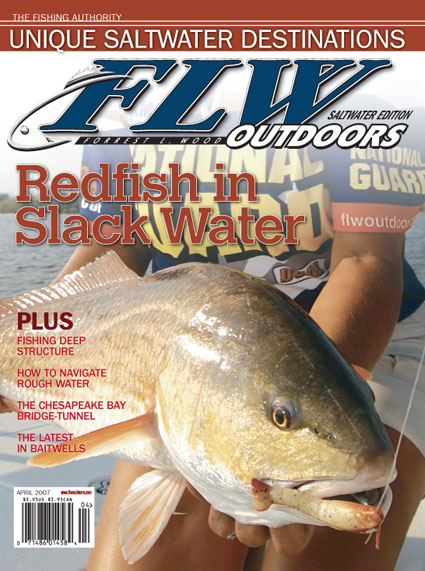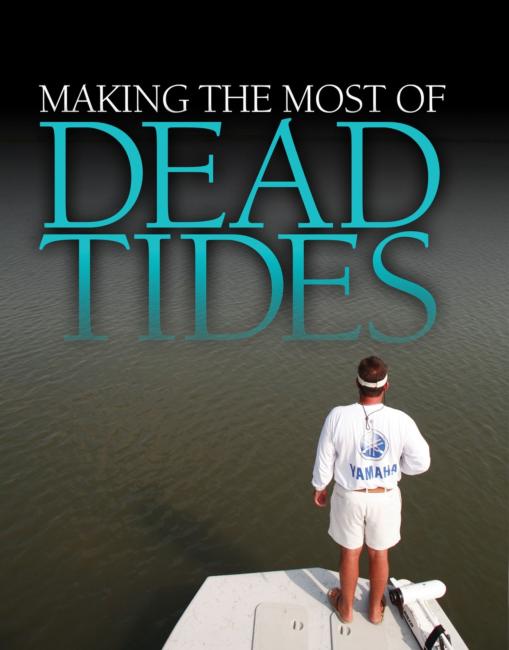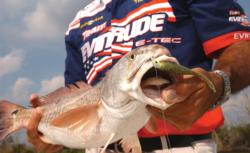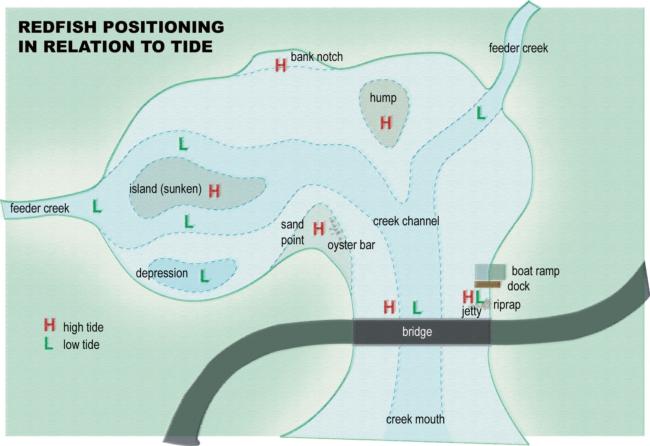Making the most of dead tides
Finding redfish opportunities in slack water

Redfish populations that are strongly influenced by tides know what the dinner bell at the local diner sounds like – it’s the sound of moving water. Whether the tide is filling a grass flat with new water, ripping out of a tidal creek, flooding a shoreline or hustling out of a pass, tidal redfish are all about water movement.
Moving water allows redfish to belly up to the all-you-can-eat buffet and slurp down tasty, helpless morsels with ease.
Anglers, too, know what the redfish dinner bell sounds like, and they purposely schedule their fishing days to be at their best spots when the water is moving.
But what about when the dinner bell quits ringing? What about when the water comes to a standstill and the flats turn into an eerie ghost town?
Some call it “dead tide,” others call it “slack tide.” Regardless of the name, it refers to a period of tide when the water has reached its lowest or highest point of the cycle and it comes to a temporary halt before turning and going the other way. Depending on location, moon phase and wind, this slack period can last anywhere from half an hour to half a day.
When the topic of dead tide comes up around redfish pros, especially those from Florida, many look at their feet and kind of mumble something under their breath.
Wal-Mart FLW Redfish Series pros from the Western Division don’t have to deal with dead tide nearly as much as their counterparts in the east. In fact, redfish anglers west of Alabama don’t have to deal with tide very much at all.
“In the marshes of Texas, Mississippi and Louisiana, tidal influence on redfish is pretty minimal,” said FLW Redfish Series pro Clark Jordan of Pearland, Texas. “Especially when compared to places like Jacksonville, Fla., where 5 or 6 feet of water runs in and out of their fishery every day. In a place like  that, tide plays a huge role in a redfish’s feeding timetable.”
that, tide plays a huge role in a redfish’s feeding timetable.”
Most Florida-based redfish anglers, with the exception of those fishing Mosquito Lagoon, have to worry about tides and, consequently, dead tides.
“Anywhere the tide is great enough to create moving water on a regular basis, fish become conditioned to it,” noted redfish pro C.A. Richardson of St. Petersburg, Fla. “They learn to feed on moving water because it’s easy, and they become inactive on slack water. That’s not to say they won’t bite in slack water, but they certainly don’t set up to ambush and feed like they do on moving water.”
It’s not just redfish, either. When the dark cloud of dead tide moves in on an estuary, everything goes, well, dead.
Baitfish quit flickering, mullet disappear, dolphins quit surfacing and water birds tuck their heads under their wings to take a nap. It’s like a national holiday on the flats.
“It’s almost frightening how lifeless everything gets during a dead tide,” described FLW Redfish Series pro Mike Laramy of Tampa, Fla. “The flat goes from this bustling field of activity to being silent. I’ve even seen schools of mullet and trout just lay dormant on the bottom during dead lows.”
So what’s an angler to do during this period of inactivity?
“It’s a good time to sit down and eat a sandwich, assuming your tournament partner brought you one, and wait out the dead tide.” Richardson joked. “Or, you can make a move to completely avoid the dead portion of the tidal cycle.”
Avoiding the slackers
As Richardson pointed out, the No. 1 remedy for anglers facing a slack tide is to avoid it altogether by running to another portion of the tide cycle. On just about any coast, it’s possible to run away from either a dead-low or dead-high slack tide by studying tide charts and out-maneuvering the sluggish periods.
Some anglers have even figured out how to “run the tide” by staying just ahead of, or just behind, the slack period. It’s much like avoiding 5 p.m. rush-hour traffic by leaving work at either 4:30 or 6:30 – the idea is to stay ahead, or behind, the period of nonmovement.
Jacksonville FLW Redfish Series pro John Henninger knows a thing or two about running northeast Florida’s drastic tide swings.
“More and more anglers are learning the key to these big tides over here on the East Coast is to run them,” Henninger said. “Our best fishing here occurs when the water first starts coming back in after a dead low. So we’re always running spot to spot and trying to stay just on the first incoming water of that dead low.”
Henninger’s run-and-gun approach is to run to a good spot in a tidal creek during the dead-low period. While the water is slack, he will stake down in position and get ready to intercept an incoming migration of redfish.
“As soon as the water starts to flush back in, the reds move in with it and it’s on,” Henninger said. “Because our tides are so fast and redfish are on the move, the flurry of action may only last 15 minutes as a group of reds passes by the boat. And when it’s over, I pull up the stakes, run out ahead of the dead-low period again, stake down at my next spot during the dead low and intercept another group coming in with the new water.”
Henninger repeats this process all day long, following the dead low all the way up the Intracoastal Waterway, cashing in on the first incoming water each time.
“You can do the same thing on a dead-high tide, turning to go out,” he advised. “As the first falling water begins, redfish reverse their path and start heading out of the creeks. It’s a matter of ambushing them on the way out.”
Running the tide takes some precise time coordination, however.
“You have to really study the tide charts, set your tidal run to follow the dead low, or high, and stick with it,” he said. “Fifteen to 30 minutes is about the maximum I give any one spot. Even if fish don’t show up on a spot as anticipated, I keep moving to stay on schedule.”
Change terrain
Henninger and other East Coast redfish pros can pull off this type of frenetic tidal run and gun because their tides are so fast. The slack portion of the tide, high or low, only lasts for about 20 to 30 minutes.
On other parts of the Florida coast, however, the tides are slower, and it can take a couple of hours for the tide to turn.
 Richardson deals with dead tides in Tampa Bay quite frequently. Another option he gives for dealing with slack water is being in the right terrain that’s more suited for a prolonged high or low water condition.
Richardson deals with dead tides in Tampa Bay quite frequently. Another option he gives for dealing with slack water is being in the right terrain that’s more suited for a prolonged high or low water condition.
“If I’m faced with a dead low for a couple hours, I’m going to put myself around some kind of channel: creek mouths, rivers, ditches or depressions,” Richardson suggested. “If I’m dealing with a dead high for a while, I want to be way up on the flats around flooded bars, humps, islands and shorelines.”
If Richardson’s advice seems strange, think of it in opposite terms. Channel-type water tends to lose its effectiveness on high water, and trying to catch reds off a semi-dry flat at low tide is nearly impossible.
“You want some feature to help congregate fish during slack water,” Richardson explained. “When the water is low, fish tend to pull into creek mouths, troughs and depressions. On high water, they move up onto bars and humps in the flats or around flooded bank contours. Being in the right terrain to better match the extended high or low tides increases your chances substantially.”
Constrictions and structure
Another trick pros use to outsmart slack tide is to fish natural or man-made features that constrict the current, thereby intensifying water flow.
Passes, river mouths, bridges, jetties, cuts in bars, saddles in between islands and man-made channels are a few examples of places that tend to squeeze every last bit of water movement out of a tide (article continued below illustration).
While the water in a bay or sound may seem to be at a standstill, getting near a pass, inlet or bridge will likely reveal more current. Even wind can generate current in these types of places.
In fact, at some major passes and inlets, slack tide affords a safe opportunity to actually fish the “outside” jetties from a small boat when the water is calm and sluggish instead of ripping and choppy.
“If we know we’re going to be dealing with a slack tide during tournament hours, we’ve always got our eyes open for some kind of structure – passes, inlets, causeways, pilings or cuts – where we can fish while waiting on a dead tide to turn,” Richardson said.
Exploratory committee
Laramy has learned to use dead-tide periods, especially low ones, to find productive fishing spots for higher tides.
“If I’m out fishing for fun or scouting for a tournament, instead of putting it on the trailer before a dead low, I’ll stay out on the water and use the low-water period to find humps, bars and knobs sticking up in vast flats. Those are the kinds of places redfish will gather around when the tide is high.”
During dead tides, Laramy often trades his fishing pole for a push pole.
“You’d be surprised at the intricacies you can uncover in a flat by poling around on it – or near it – for a couple hours of dead low,” he revealed. “I’ve found some of my best high-tide hot spots this way.”
The same type of exploration is possible on a dead high as well. Having an extra 2 feet of water held up around shorelines on a prolonged dead high provides an opportunity to explore shorelines of creeks, bays and inlets with much greater speed and maneuverability.
Finding remnants of an old dock, a point sweetened with an oyster knob or a deep notch in the bank pooling up finger mullet may not be productive when the tide is slack, but visiting it again in falling water could provide a nice payoff.
“Redfishing is not always just about catching,” Laramy added. “It’s also about exploring to find new areas, and dead tides are a great time to do that.”
